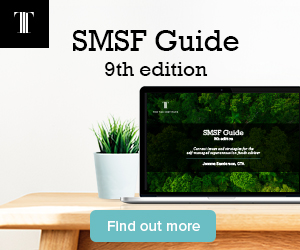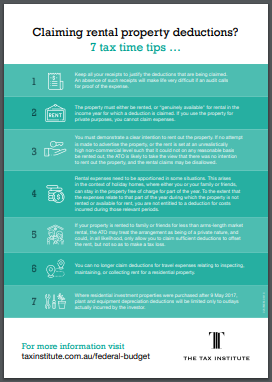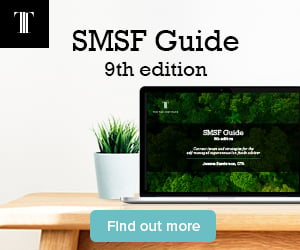The CGT small business concessions (CGT SBC) were originally introduced in the context of providing tax concessions for small business owners (and farmers) who treated their businesses as their “superannuation” and were denied the multitude of tax benefits that employees (and, particularly, public servants) could access through contributions to superannuation funds. Therefore, the ability to utilise the CGT SBC is highly valuable, as it enables a taxpayer to disregard a gain, as well as enabling a higher level of wealth to be added to superannuation.
This post excerpts chapter five of the new ninth edition of SMSF Guide, 'CGT small business concessions and superannuation', by Jemma Sanderson, CTA.
It is not the purpose of this publication to detail the operation of these concessions. Rather, the focus is on the interaction of these concessions with superannuation. Further, with additional changes announced by the federal government regarding the small business concessions, it is imperative that the eligibility for any taxpayer is considered in detail. However, for completeness, set out below is some background to the operation of the concessions.
CGT SBC – overview
There are four specific concessions in Div 152 ITAA97:
- the CGT SBC 15‑year exemption – which generally requires a sale of an asset which has been held for at least 15 years and the sale is in respect of the retirement of someone who is over 55 (Subdiv 152-B);
- the CGT SBC 50% reduction (Subdiv 152-C);
- the CGT SBC retirement exemption – which provides an exemption of up to $500,000 per relevant individual, and does not require anyone to retire (despite the words used in the section). However, if the relevant individuals are under 55, the exempt amount must be contributed to a super fund (Subdiv 152-D); and
- the CGT SBC roll-over which provides for an automatic deferral of two years for any taxable amount left after applying the general CGT discount, the CGT SBC discount and/or the CGT SBC retirement exemption (Subdiv 152-E). Note: If the taxpayer acquires a replacement asset (as that term is defined) within a requisite two-year period, the deferral can extend beyond two years.
There are two threshold conditions for relief under the CGT SBC, outlined in Subdiv 152‑A, and they are as follows (assuming you – the taxpayer – have a CGT event and that a gain would result but for the concessions):
a) you are a small business entity (SBE) for the income year (which relates to businesses with a turnover under $2m);
b) you satisfy the $6m maximum net asset value test;
c) you are a partner in a partnership that is an SBE for the income year and the CGT asset is an asset of the partnership;
d) you own an asset and do not carry on a business yourself (other than in partnership) and the asset is used in the business of an entity which is an SBE and which is either connected with you or is your affiliate;
e) you own an asset, and you are a partner in a partnership which is an SBE and that partnership uses your asset in its business; and
2) the CGT asset satisfies the active asset test.
- if you are an individual with the CGT event, you are a CGT concession stakeholder in the object company or trust; or
- if the CGT event happens to a company or trust, there are CGT concession stakeholders in the object company or trust together have a small business participation percentage (SBPP) in you of at least 90%.
The definition of a CGT concession stakeholder is complex and beyond the scope of this publication.
Application of the concessions
- where the claim is made by an individual, if that individual is under 55 at the time they lodge their tax return for the year of the gain (regardless of due date for lodgment) the amount must be contributed to a superannuation fund on their behalf. The contribution will be treated as if it was a non-concessional contribution made on behalf of the taxpayer, unless the taxpayer elects that it counts under the CGT cap;
- if the claim is made by a company or a trust, the exempt amount must be paid out to, or to a superannuation fund on behalf of, individuals who are CGT concession stakeholders in the company or trust by the time the company lodges its tax return for the year of the gain (regardless of the due date for lodgment). If the CGT concession stakeholders are under 55 at the relevant time, the payment must be made by the company or trust directly to the superannuation fund. However, the contribution will be treated as if it was a non-concessional contribution made on behalf of the taxpayer, unless the taxpayer elects that it counts under the CGT cap. If the individuals are 55 or over, the exempt amount does not have to be paid to a superannuation fund, but must still be paid to them;
- in both of the above scenarios, the time for the contribution to the super fund can be extended in certain cases where the proceeds for sale have not been received as at the tax return lodgment time. Further, the Commissioner does have a discretion to grant an extension of the time to make the superannuation contribution; and
- where a company or trust is claiming the CGT SBC retirement exemption it must make an election in writing to do so which notes the individual CGT concession stakeholders in respect of whom the claim was made and the amount or percentage of the exempt gain per stakeholder
In addition to the concessional contributions cap and the non‑concessional contributions cap, every individual has a CGT cap up to a lifetime limit (this amount was $1m in the 2007 year and is indexed each year – it is $1.48m in 2018-19).
The CGT cap covers contributions made to a super fund in respect of an individual in any of the following circumstances:
- the individual has made a capital gain that is eligible for the CGT SBC 15‑year exemption;
- the individual is a CGT concession stakeholder in a company or trust, and that company or trust has been eligible for the CGT SBC 15‑year exemption and has paid the exempt amount to that individual (in accordance with the requirements of the CGT SBC provisions);
- the individual has sold a pre-CGT asset and would have been eligible for the CGT SBC 15‑year exemption if the asset was a post-CGT asset;
- the individual is a CGT concession stakeholder in a company or trust, and that company or trust has sold a pre‑CGT asset that, had the asset been post-CGT, would have been eligible for the CGT SBC 15‑year exemption, and the company or trust has paid the exempt amount to that individual (in accordance with the requirements of the CGT SBC provisions);
- the individual has made a capital gain and the individual is eligible to claim the CGT SBC retirement exemption in respect to that gain; and
- the individual is a CGT concession stakeholder in a company or trust which has made a gain eligible for the CGT SBC retirement exemption, and the individual receives a payment of the type that qualifies the entity for the exemption.
In SMSF Guide, 9th edition, the author looks in more detail here at amounts which are subject to the CGT cap, the CGT SBC 15‑year exemption, and the CGT SBC retirement exemption, providing a number of worked examples and tips, as well as links to relevant ATO materials, before looking at when contributions must be made.
When must the contribution be made?
- for individuals claiming the CGT SBC 15‑year exemption, or who have sold a pre‑CGT asset which would have otherwise been eligible for the CGT SBC 15‑year exemption – the contribution to the superannuation fund must be made on or before the later of:
- the day the individual is required to lodge their tax return for the year of the gain; and
- 30 days after the proceeds are received;
- for individuals who are CGT concession stakeholders in an entity which makes a gain which is eligible for the CGT SBC 15‑year exemption, or which makes a gain on a pre‑CGT asset which would otherwise be eligible for the CGT SBC 15‑year exemption, and who received a payment from the entity in respect of that gain – the contribution to the superannuation fund must be made within 30 days of receiving the payment from the entity which made the gain;
- for individuals claiming the CGT SBC retirement exemption – the contribution must be made on or before the later of:
- the day the individual is required to lodge their tax return for the year of the gain; and
- 30 days after the proceeds are received;
- for individuals who are CGT concession stakeholders in an entity which makes a gain in respect of which it claims an exempt amount pursuant to the CGT SBC retirement exemption, and the entity makes a payment to, or on behalf of, that CGT concession stakeholder – the contribution must be made within 30 days of the payment by the entity.
Note: In the above time limits for the CGT cap, where reference is made to the day on which the individual is required to lodge their income tax return, this is a reference to the due date for lodgment. However, for the purposes of the CGT SBC retirement exemption, the legislation only requires payments to be made by reference to the actual date of lodgment of the relevant taxpayer’s return. This distinction is important:
- while an individual under 55 who seeks to claim the CGT SBC retirement exemption has until the time of actual lodgment of their tax return to make the required super contribution so as to be able to claim the tax exemption (even if the tax return is lodged months or years late), if they want the contribution to count under the CGT cap, the contribution must be made by the due date for lodgment; and
- the different timing requirements can mean that, while an individual is entitled to claim the CGT SBC retirement exemption in respect of a gain, it may be that he is not entitled to use the CGT cap in respect of the contribution if he lodges and pays after the due date for lodgment of the relevant tax return.
The chapter ends by looking at notice requirements and the CGT cap and maximising the amount to contribute to superannuation, providing a number of worked examples and tips and traps to be aware of.
The SMSF Guide has been updated and revised for 2018, and includes substantial strategies, issues and considerations in light of the fair and sustainable superannuation provisions that impacted many SMSFs in the lead-up to 30 June 2017. It also covers how they continue to have a considerable impact on clients.
Importantly, this new landscape has substantially affected estate planning for all SMSF members and the guide considers the issues in detail, outlining strategies and the key areas to address.
Designed around the life cycle of an SMSF, the guide provides an update on recent developments and the practical implications that affect your clients. Find out more on our website.
Jemma Sanderson, CTA, is a Principal of Cooper Partners Financial Services, heading up its SMSF specialist services. Jemma provides strategic advice on SMSFs, estate planning and wealth management to clients, as well as technical support to accounting, legal and financial planning groups.










